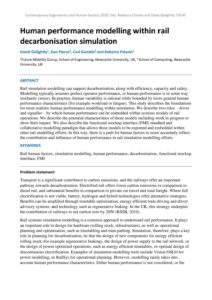| Document | Author David Golightly, Ken Pierce, Carl Gamble and Roberto Palacin |
| Abstract Rail simulation modelling can support decarbonisation, along with efficiency, capacity and safety. Modelling typically assumes perfect operator performance, or human performance is in some way stochastic (noise). In practice, human variability is rational while bounded by more general human performance characteristics (for example workload or fatigue). This study describes the foundations for more realistic human performance modelling within simulation. We describe two roles – driver and signaller – by which human performance can be embedded within systems models of rail operations. We describe the potential characteristics of those models including work in progress to show their impact. We also describe the functional mockup interface (FMI) standard and collaborative modelling paradigm that allows these models to be exported and embedded within other rail modelling efforts. In this way, there is a path for human factors to more accurately reflect the contribution and influence of human performance in rail simulation modelling efforts. |

